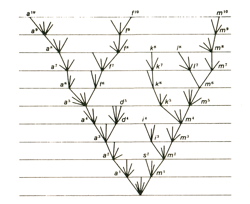Stabilization Theory
An alternative theory of evolution
|
|
EUGENE M. MCCARTHY, PHD GENETICS
The main claims of stabilization theory, which distinguish it from neo-Darwinian theory, can be summarized as follows:
- The typical form treated as a species comes into being via certain well-known, well-documented genetic processes ("stabilization processes") that produce new stable forms in an extremely rapid manner;
- These processes produce new forms that are, for genetic reasons, inherently stable from the time of their inception right up to the time of their extinction. A corollary of this claim is the theory's assertion that any given type of organism produced by such a process has a negligible tendency to change over time in response to environmental constraints.

|
| Darwin's picture of evolution (From The Origin of Species) |
- The typical new form treated as a distinct species comes into being gradually through the accumulation of certain characteristic traits within an evolving population over time;
- The accumulation and spread of these traits is due to environmental influences favoring the survival and reproduction of individuals having such traits (natural selection).
Only a few words of difference, but the implications are huge. Consider how extensively Darwinian theory has influenced not only biology, but also society at large and you will see that the stakes here are incredibly high — what if the axioms of Darwin's theory actually are erroneous? — and subsequent discussion will provide excellent reasons for believing they actually are — Then the theory itself is wrong and the entire Weltanschauung based upon it is mistaken. For example, under stabilization theory we select and shape our environment. The neo-Darwinian outlook, of course, is just the opposite: Under that view, the environment selects and shapes us.
As we shall see, the relative merits of these two hypotheses can in fact be evaluated by considering which of the two is more consistent with available data. But first, let's look at some examples of stabilization processes.
Introduction to stabilization theory >>
Most shared on Macroevolution.net:
Human Origins: Are we hybrids?
On the Origins of New Forms of Life
Mammalian Hybrids
Cat-rabbit Hybrids: Fact or fiction?
Famous Biologists
Dog-cow Hybrids
Prothero: A Rebuttal
Branches of Biology
Dog-fox Hybrids